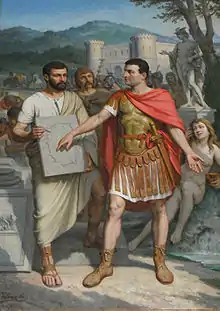Joseph Villevieille | |
|---|---|
 Joseph Villevieille in 1901 | |
| Born | 6 August 1829 |
| Died | 11 February 1916 (aged 86) Aix-en-Provence, Bouches-du-Rhône, Provence-Alpes-Côte d'Azur, France |
| Resting place | Saint-Pierre Cemetery |
| Alma mater | École des Beaux-Arts |
| Occupation | Painter |
Joseph Villevieille (1829–1916) was a French painter.
Early life
Joseph Villevieille was born on 6 August 1829 in Aix-en-Provence.[1][2] He graduated from the École des Beaux-Arts in Paris.[1]
Career
Villevieille taught painting in Aix-en-Provence.[1] He became friends with Paul Cézanne,[3] whose mother he painted shortly before she died.[1]
When the townhall of Aix-en-Provence was burgled on 22 August 1872, Villevieille was commissioned to do many paintings for its walls.[1] Some of those paintings were portraits of prominent local painters like Jean-Baptiste van Loo and François Marius Granet, and local historian Scholastique Pitton.[1] In 1900, he did a painting of Sextius Calvinus, the founder of Aix-en-Provence, which is also in the collection of the townhall.[1]

Death and legacy
Villevieille died on 11 February 1916 in Aix-en-Provence.[1] He was buried at the Saint-Pierre Cemetery in Aix-en-Provence.[1] The Avenue joseph villevieille in Aix-en-Provence was named in his honor.[4]
References
- 1 2 3 4 5 6 7 8 9 Baille, Franck (1981). Les Petits Maîtres d'Aix à la Belle-Époque (1870-1914). Aix-en-Provence: Edition de l'imprimerie Paul-Roubaud. pp. 37–38.
- ↑ "Joseph Villevieille (French, 1829 - 1916)". MutualArt.com. Retrieved December 4, 2015.
- ↑ Danchev, Alex (October 4, 2013). "'Mon cher Émile': The Letters of Paul Cézanne to Émile Zola". The Daily Telegraph. Retrieved December 4, 2015.
- ↑ Google Maps